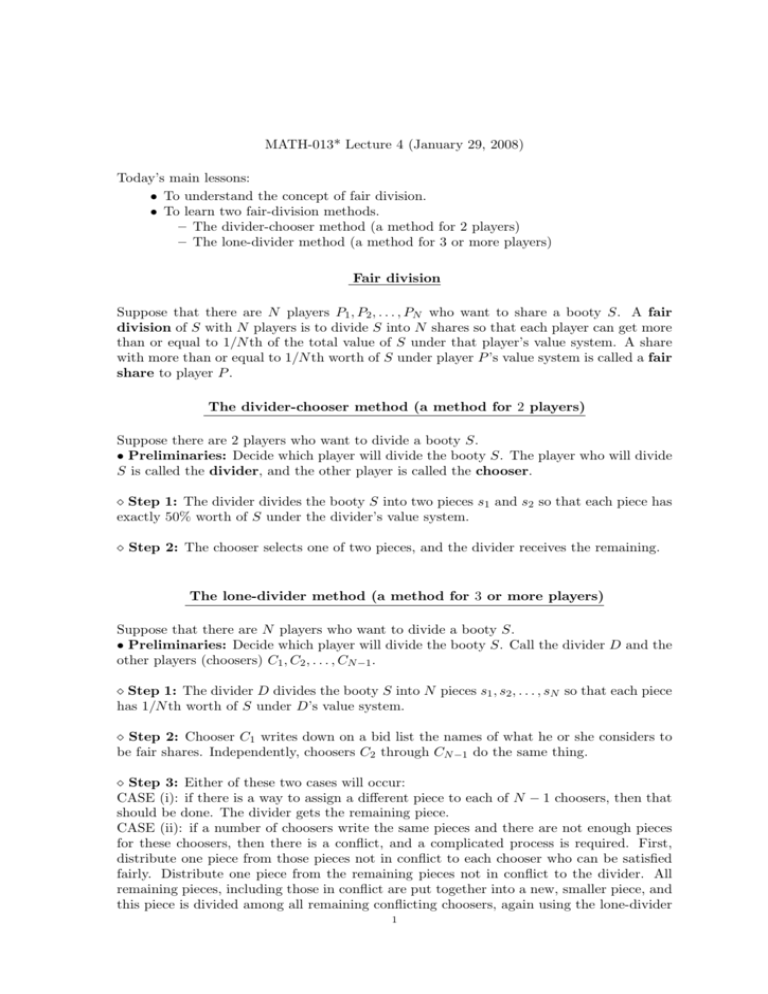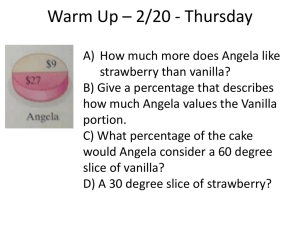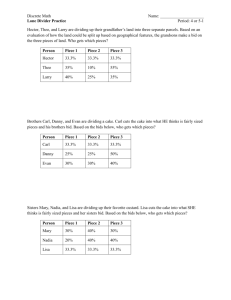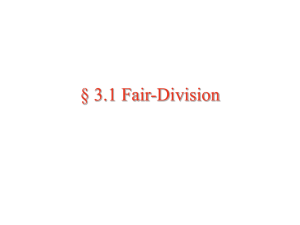Weekly Assignment #4
advertisement

MATH-013* Lecture 4 (January 29, 2008)
Today’s main lessons:
• To understand the concept of fair division.
• To learn two fair-division methods.
– The divider-chooser method (a method for 2 players)
– The lone-divider method (a method for 3 or more players)
Fair division
Suppose that there are N players P1 , P2 , . . . , PN who want to share a booty S. A fair
division of S with N players is to divide S into N shares so that each player can get more
than or equal to 1/N th of the total value of S under that player’s value system. A share
with more than or equal to 1/N th worth of S under player P ’s value system is called a fair
share to player P .
The divider-chooser method (a method for 2 players)
Suppose there are 2 players who want to divide a booty S.
• Preliminaries: Decide which player will divide the booty S. The player who will divide
S is called the divider, and the other player is called the chooser.
¦ Step 1: The divider divides the booty S into two pieces s1 and s2 so that each piece has
exactly 50% worth of S under the divider’s value system.
¦ Step 2: The chooser selects one of two pieces, and the divider receives the remaining.
The lone-divider method (a method for 3 or more players)
Suppose that there are N players who want to divide a booty S.
• Preliminaries: Decide which player will divide the booty S. Call the divider D and the
other players (choosers) C1 , C2 , . . . , CN −1 .
¦ Step 1: The divider D divides the booty S into N pieces s1 , s2 , . . . , sN so that each piece
has 1/N th worth of S under D’s value system.
¦ Step 2: Chooser C1 writes down on a bid list the names of what he or she considers to
be fair shares. Independently, choosers C2 through CN −1 do the same thing.
¦ Step 3: Either of these two cases will occur:
CASE (i): if there is a way to assign a different piece to each of N − 1 choosers, then that
should be done. The divider gets the remaining piece.
CASE (ii): if a number of choosers write the same pieces and there are not enough pieces
for these choosers, then there is a conflict, and a complicated process is required. First,
distribute one piece from those pieces not in conflict to each chooser who can be satisfied
fairly. Distribute one piece from the remaining pieces not in conflict to the divider. All
remaining pieces, including those in conflict are put together into a new, smaller piece, and
this piece is divided among all remaining conflicting choosers, again using the lone-divider
1
2
method.
NOTE: It is better to be a chooser than a divider!; If there are N players, the divider has
to divide S into N pieces so that each piece has 1/N th worth of S under the divider’s value
system. Therefore, the divider always ends up picking a piece with 1/N th worth of S. On
the other hand, a chooser has a chance to get a piece worth more than 1/N th of S under
the chooser’s value system. Since fair-division methods must be fair to all players, every
player should be given an equal chance of becoming a chooser. One easy way to solve this
problem would be a coin toss (only for the case of 2 players) or a random draw.
Weekly Assignment 4 (Due: February 6th, 2008)
You may hand in your complete assignment at the next class (February 5th), or the
following day at the math department office (Jeffery 310). Assignments should be stapled
and clearly labeled with your full name, student number and the class number.
1. Question 4 of Chapter 3; 6th edition (Question 4 of Chapter 3; 5th edition)
2. Amy, Brandon, Chris and David are dividing a cake among themselves. The cake is
divided into four pieces s1 , s2 , s3 and s4 .
(a) To Amy, the value of the whole cake is $15.00. Also, she values s1 at $3.00, s4 at $3.50,
s2 and s3 are of equal value. Indicate which of the four pieces are fair shares to Amy.
(b) To Brandon, all pieces have equal value. Indicate which of the four pieces are fair shares
to Brandon.
(c) To Chris, s1 , s2 and s4 have equal value, and the value of s3 is three times the value of
s1 . Indicate which of the four pieces are fair shares to Chris.
(d) To David, the value of the whole cake is $18.00. Also, s2 , s3 and s4 have equal value,
and s1 is $2.00 more than the value of s2 . Indicate which of four pieces are fair shares to
David.
(e) Using your results from (a) through (d), describe a fair division of the cake.
3. Question 14 of Chapter 3; 6th edition (Question 10 of Chapter 3; 5th edition)
4. Question 16 of Chapter 3; 6th edition (Question 12 of Chapter 3; 5th edition)
5. Question 17 of Chapter 3; 6th edition (Question 13 of Chapter 3; 5th edition)
6. Four players C1 , C2 , C3 and D are dividing a plot of land among themselves by using the
lone-divider method. Player D divides the land into four parcels s1 , s2 , s3 and s4 . When
the chooser’s bid lists are opened, C1 ’s bid list is {s2 , s3 }, C2 ’s bid list is {s3 , s4 }, and C3 ’s
bid list is {s4 }. Find all possible fair divisions of the land.
7. Five players C1 , C2 , C3 , C4 and D are dividing a cake among themselves by using the
lone-divider method. Player D divides the cake into five pieces s1 , s2 , s3 , s4 and s5 . When
the chooser’s bid lists are opened, C1 ’s bid list is {s2 , s4 }, C2 ’s bid list is {s2 , s4 }, C3 ’s bid
list is {s2 , s3 , s4 }, and C4 ’s bid list is {s2 , s3 , s5 }. Find all possible fair divisions of the cake.
8. Question 28 of Chapter 3; 6th edition (Question 22 of Chapter 3; 5th edition)











